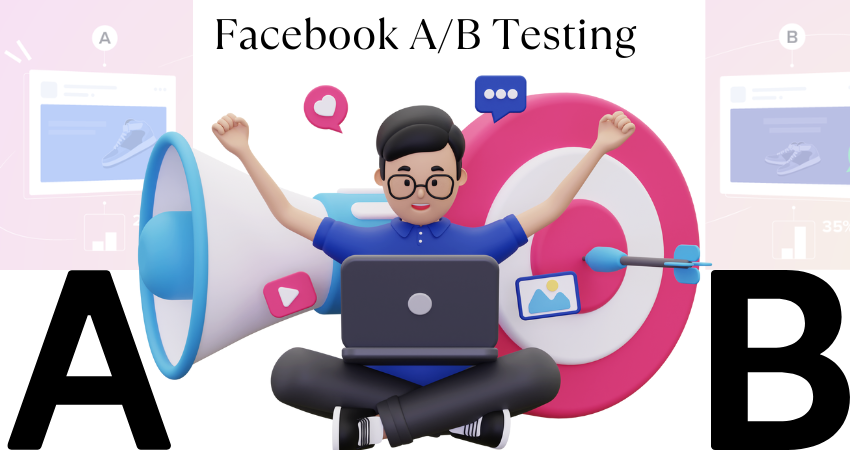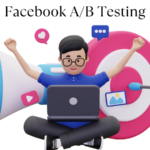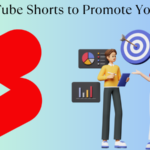Facebook A/B Testing – Best Ways to Optimize Facebook Ads
Whether you have one dollar or thousands of dollars to invest per day on Facebook ads, the goal is to keep costs low by serving great ads. However, what you think is a great advertisement may not be the best advertisement. A/B testing allows you to determine what the data indicates systematically is the ideal ad for your audience. However, if you are still getting familiar with the Facebook Ads platform, it can be time-consuming. This blog will show you 7 effective ways to optimise your Facebook marketing through AB testing Facebook ads. But first, let’s go over the fundamentals.

What Is A/B Testing?
A/B testing, also known as split testing, is a strategy for determining which ad headlines, body copy, images, call-to-actions, or a combination of the above work best for your target audience. Furthermore, you can test different Facebook audiences and ad placements to determine who your ideal audience is and which placements they can be reached with. Typically, A/B tests are published for a couple of weeks while advertisers wait for new results. Following the completion of the experiment, a decision will be made as to whether one option outperformed the other (s). Using a statistical significance calculator, you can ensure that your results are statistically significant. Unless you’ve already created a large number of Facebook ad campaigns for your product, predicting what type of ad design will work best for you or which demographic audience will be more likely to buy your product will be difficult. This is where A/B testing can help: You can repeat test multiple ad designs and target audiences to determine which ones are most effective.
Prevent audience overlaps
Your audience should be large enough to support your test and be different from any other Facebook campaign you run concurrently. AB testing Facebook ads has the significant advantage of avoiding audience overlap. This prevents the same audience from seeing multiple ad variants. This is advantageous because if multiple variants of an ad are shown to an audience, the results may be influenced. Thus, by avoiding audience overlap, Facebook ad A/B testing avoids contaminated test results and allows you to be confident in the best-performing variant.
Test only one element at a time
While it may be tempting to test all of your ideas right away, you can only determine which aspects of your campaign were successful later. Trying to test multiple variables at the same time will result in a complete disaster. To avoid confusion, only test one thing at a time. If you want to test target audiences, make sure the ad placements and creatives are the same for both. As long as the ad sets are consistent across audiences, placements, and budgets, each ad creative you’re testing should be placed in its own set.
Don’t conclude the test too early
Even if you are tempted to get your A/B test results quickly and apply the findings to your current campaigns, you should wait at least 72 hours before drawing any conclusions. It takes approximately 24 hours for Facebook’s algorithms to begin delivering a new ad campaign. The same algorithms will take longer to learn about and optimise your creatives and audiences. The greater the number of conversions received by Facebook algorithms, the faster they can exit the Learning Phase. This phase usually takes around 50 conversions to complete. Before pausing the campaigns, ensure all your test versions have at least 100 conversions.
Test different concepts
It is already difficult to obtain adequate test sample sizes for generating significant results when A/B testing Facebook ads. As a result, for the single create element you’re testing, you should prioritise testing distinguishable concepts. For example, if you’re testing an image, don’t just change one element of it—try something completely different. If you’re testing a video, don’t just change the ending scene; start your video with a different value proposition or compare a short video to a long one.
Apply new findings to existing campaigns
You’ve completed the A/B test and have the results. Keep in mind that not all tests result in a clear winner and new top-performing findings. But what happens if your test is a success? If you have campaigns that have been running for a long time, it is best to make the changes within those campaigns. You’ll benefit from keeping the previous conversion data this way. Avoid the temptation to launch new campaigns every week or month. Instead, use a single primary campaign for a longer period of time and make changes within that campaign.
Plan ahead for your testings
Creating a Facebook ad test is only one step in the process. You’ll need approval from other team members, confirm the budget, and cooperate with the design team to receive ad creatives before creating the test campaigns. This could take a week or more. Wait to put everything off until the last minute. To maintain a constant flow of A/B tests, plan each test at least two weeks ahead of time. Making a spreadsheet with test ideas, prioritisation, and timelines is one of the simplest ways to keep all teams informed.
Deal with ad fatigue
Even the best-performing ads may have fewer impressions, lower click-through rates, and lower engagement. This is due to a phenomenon known as ad fatigue, in which your audience loses interest and stops engaging with your ads as a result of repeatedly viewing your ad. As a result, campaign efficiency and ROI are reduced. Creating multiple ads and rotating them is one way to combat fatigue. All of these versions can deliver the same content but should be distinct in terms of design or text. This keeps your content current. You can also A/B test to find the best performers and serve them to your visitors.
Conclusion
AB evaluation Facebook ads can assist you in successfully marketing yourself on Facebook, where many of your potential customers spend their time. We’ve compiled a list of 5 tried-and-true methods for optimising Facebook ads using A/B testing. They can assist you in increasing impressions, engagement rates, and click-through rates. Use them to succeed in your future campaigns.




